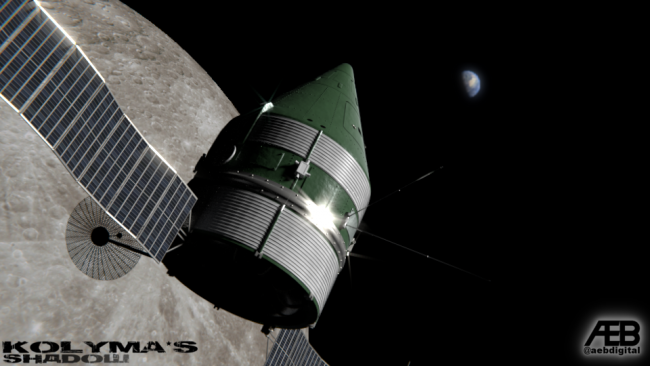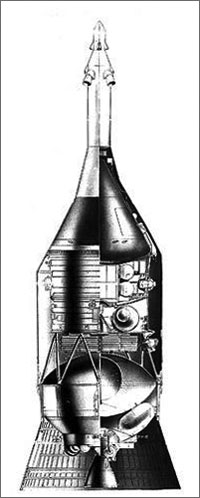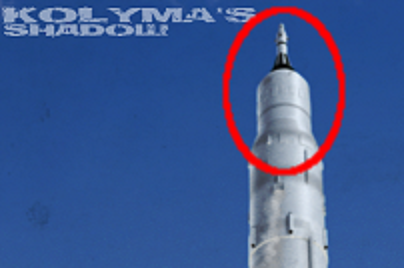Drunkrobot said:
I just read through the whole timeline, and I've got to say that I'm loving it so far. It's even got me to start a space TL of my own!
Glad you’re enjoying it! I was similarly inspired by the great (and regrettably now late)
Eyes Turned Skyward, so I’m happy to continue the chain!
So, after last week’s look ahead, it’s time for us to return to where we left Part-III - a launchpad at Cape Canaveral - for the next installment of...
Part IV Post#2: Over the Moon
As the Minerva-B24 rocket of the Columbia-6 mission rose into the sky above Cape Canaveral on Friday 23rd January 1976, its two-man crew carried with them the hopes and dreams of generations of scientific romantics. Their mission, to circle the Moon, was the same as that envisaged by Jules Verne 111 years earlier, and as with that fictional voyage, the journey of Columbia was not entirely incident free.
The separation of the four kerolox boosters occurred exactly to schedule, but the larger core first stage booster shut down slightly too soon, necessitating a longer second stage burn and a further boost from the Centaur upper stage to place Columbia into its trans-lunar trajectory. The upper stage was “running on vapours” by the time it separated from the Columbia Command and Service Module, but mission controllers at Vandenberg soon confirmed that Dave Merricks and Gary Jones were within a few tens of miles of their planned trajectory and still a “go” for the mission. Ten hours later, Jones executed a three-second mid-course burn to bring this figure down to within a mile.
The rest of the cruise to the Moon proceeded relatively uneventfully from a mission standpoint, though a fault in the handheld TV camera carried on board meant that the planned television broadcast on day two of the mission had to be abandoned after just a couple of minutes, as the received images proved to be unwatchable. Merricks and Jones continued to make audio broadcasts to international news organisations, with the lightspeed lag in interviews becoming more noticeable as they continued to recede from the Earth. They also took many still photographs whenever the command module’s small windows were orientated towards either Earth or Moon, including the most famous (though not the first) of the various “Blue Marble” pictures that became a symbol of the environmental movement in the late ‘70s.
Sixty-nine hours into the mission, Columbia-6 entered one of its most critical phases as the capsule passed behind the lunar disk and out of contact with Mission Control. During this dark period, Merricks and Jones would have to trigger their service module engine for the Lunar Orbit Capture manoeuvre. The first indication controllers would have of the success of the manoeuvre would be the timing of the first radio signal from the ship as it rounded the Moon. If Columbia re-established contact ahead of schedule, it would mean that the burn hadn’t been completed or that the engine had failed to start, and the crew would coast back towards Earth on a free-return trajectory. On the other hand, if the signal failed to reappear within a minute or so of the expected time, then in all probability the ship was lost and the crew would never be heard from again. Millions of television viewers tuned in to live news programmes as the minutes ticked by before contact was scheduled to be re-established, the tension rising with every repetition of the prayer “Columbia, Vandenberg. Over…”
Finally, at the fifth asking, the reply came back “Vandenberg, Columbia. LOC burn completed.”
“Columbia, Vandenberg. Roger that, good to hear your voice Dave. Any problems to report?”
“No problems, all systems nominal. Gary thought he spotted a strange pyramid on the farside, but we’re pretty sure it was just a mountain.”
“Ah, say again, Columbia.”
“Just kidding, Vandenberg…”
For the next twenty hours, Columbia-6 orbited the Moon at an average altitude of 180 km. In that time, Merricks and Jones took hundreds of highly detailed photographs of the lunar surface, both with their handheld cameras and with the 4” telescopic camera mounted in the nose of the command module. Other instruments in the service module recorded electrical and magnetic field data, as well as the incidence of high energy particles. The most exotic instrument carried was a “LIDAR” laser altimeter, which provided highly accurate readings of Columbia’s altitude above the surface, the first use of such an instrument on another heavenly body.
The most important event for the man who had linked his political reputation to the mission came on the second orbit of the Moon, when President Muskie spoke to the astronauts from the White House in “the most incredible telephone call ever made from this office.” In a five-minute speech, the President praised the commitment and abilities of the astronauts, NACAA and the Air Force in rising to his challenge, and expressed his hope that America would use this achievement as a jumping-off point to even greater advances “including a landing on the lunar surface itself.” This was a reference to the Columbia Advanced Missions studies that Muskie had authorised, in what was widely seen as an effort to secure a legacy as he entered the final year of what was generally felt to be a failing presidency.
Finally, almost a day after their arrival and following a few hours of sleep, it was time for Merricks and Jones to bid farewell to the Moon and start their journey home. As with the LOC manoeuvre, the Lunar Orbit Escape burn would occur over the farside and out of contact with Earth. LOE was considered even more critical than LOC, as it relied upon the SME engine successfully re-starting almost a day after its previous burn, with failure meaning not a free-return coast back to Earth, but rather condemning the crew to an ever-decaying orbit about the Moon. Once again, viewers on Earth held their breath.
When contact was re-established, five seconds earlier than anticipated, readings confirmed that the SME had once again performed flawlessly, and Columbia-6 was on a trajectory to bring her into Earth’s atmosphere 57 hours later. The burn was in fact so accurate that the first of two planned mid-course manoeuvres was scrubbed as unnecessary. The cruise home suffered only one minor scare, when twelve hours from Earth one of the command module batteries shorted and failed. The remaining units were quickly confirmed to be in working order, and they held sufficient charge to support the module between separation from the service module and splashdown, so the crew were never in real danger. Nonetheless, Merricks and Jones were instructed to reconfigure the CM’s systems to reduce their power usage, just to be on the safe side.
As the time for atmospheric entry approached, weather at the splash-down site off the coast of Florida was reported to be a little rough, but still within mission rules, and the service module was jettisoned on-schedule as Merricks and Jones strapped themselves in for the command module’s fiery descent. The capsule’s ablative heat shield once again worked perfectly (although Jones later noted that “watching chunks of your shield fly past the window can be darn scary when you’re used to a Dynasoar re-entry!”), and Columbia-6 splashed down in the Atlantic Ocean seventeen nautical miles from the recovery vessel, the carrier USS Enterprise.
Splashdown for Columbia-6, the first manned flight around the Moon, 29th January 1976.
The successful Columbia-6 mission helped to kick off a year of celebrations of the 200th anniversary of the Declaration of Independence but, despite this strong start, many of those celebrations came to be viewed with cynicism by an increasingly weary nation. Two years after the Oil Shock and subsequent collapse of the Bretton Woods system, the country was still suffering the effects of “stagflation”, severely damping many people’s enthusiasm for the anniversary. Muskie had delegated much of the responsibility for organising the celebrations to his Vice President, George McGovern, who at that time was still in the running to be the Democratic Party’s nominee for the 1976 presidential elections. The primaries campaign was becoming increasingly bitter, with the front-runner, former Secretary of State Robert Kennedy, accusing McGovern of attempting to exploit the celebrations, including Columbia, to boost his own chances. Regardless of whether or not this was in fact McGovern’s plan, the mud-slinging surrounding the events lent a sour note to what should have been a time of national unity and rejoicing.
This turning of the political mood may have contributed to NACAA Chairman Edgar Cortright’s recommendation to the President that the next Columbia mission be postponed whilst the issues noted on Columbia-6 were ironed out. When Muskie had made his announcement back in 1970, he had originally intended to have a mission in progress over the July 4th holiday itself, but the iron laws of celestial mechanics made this impractical. It was quickly discovered that the last launch window from Cape Canaveral before the 4th would occur more than three weeks earlier, well beyond the practical endurance of a Columbia mission. It was in part this limitation that had driven Muskie to declare “mission accomplished” in his Columbia-6 phone call, and so given this, plus the unthinkable consequences should an accident befall Columbia-7, it was agreed in a meeting on 8th March that the next mission should be delayed to give the engineers more time to ensure everything was ship-shape. This would also push the mission to after the Democratic National Convention, hopefully preventing it from becoming a political football in the primaries.
Barely had the decision to postpone been taken than the Soviet reply to Columbia was received. On Saturday 20th March 1976 a Proton booster lifted off from Tyuratam with a Sapfir-L spacecraft at its tip. Jammed inside the diminutive capsule were cosmonauts Viktor Petrov and Juris Mēness, both veterans of Earth-orbital Orel missions. Although theoretically capable of carrying a crew of three for missions to LEO, weight-growth issues had forced Chelomei in 1973 to downgrade Sapfir-L to a two-man capsule[1]. He still hoped to expand it to a crew of three at some future date, pinning his hopes on Glushko’s recent advancements in hydrolox engine development to allow him to add a high-energy upper stage to Proton in the late ‘70s, but in order to meet the American challenge whilst still besting Mishin’s Zarya, a two-man crew would have to do.
As on the Earth orbit test conducted following Proton’s return to flight in November 1975, the initial launch passed off without any problems. Following 3rd stage separation, the Blok-D upper stage successfully fired, injecting the VA/AOO modules onto its trans-lunar trajectory. It was at this point that TASS made the formal announcement that the Soviet Union was matching the Americans’ Columbia-6 mission with their own Sapfir-2, a designation that continued the Soviet practice of ignoring unsuccessful missions and secret test flights wherever possible.
The mission at first followed much the same profile as Columbia-6, with Petrov and Mēness making a few short radio interviews in which they reported their high spirits and excitement to be part of such an historic mission. Unlike Columbia, Sapfir’s wafer-thin mass limits meant that no bulky TV system was even installed, but given that Columbia-6 had been unable to transmit television images either this shortcoming was less noticeable.
The most significant difference between the Columbia and Sapfir missions became apparent on 23rd March, as the Soviet spacecraft approached its target. As with Columbia-6, there was a tense wait for Sapfir-2 to reappear from behind the Moon, but this time the returning signal heralded not a successful capture into lunar orbit, but rather the beginning of Sapfir’s journey home, as she swung around the Moon and headed straight back to Earth.
During the first half of their high-speed pass over the farside, Petrov and Mēness had been fully engaged in taking high-resolution photographs of the surface feature beneath them, using a telescopic camera located in the AOO, with the film being later retrieved by the cosmonauts via a small hatch in the VS’s heat shield - an innovation that had caused some considerable debate amongst the design team and absorbed a lot of test resources to validate. Sapfir passed over the terminator shortly after its closest approach to the Moon, after which the cosmonauts focussed on preparing their ship for the planned trans-Earth correction manoeuvre shortly after re-establishing contact with Moscow. In total, Petrov and Mēness spent less than an hour of their encounter on lunar science.
Sapfir-2 rounds the Moon, 23rd March 1976.
Following their trouble-free lunar encounter, the almost three-day journey back to Earth became increasingly tense as the small capsule’s systems struggled to cope with the load placed on them. Several minor systems began to malfunction as the fourth day of the mission passed into the fifth. This included a failure of one of the three star trackers, and a worrying, though brief, loss of contact with Earth when the high-gain antenna lost lock. Tempers also began to fray in the capsule, as Petrov and Mēness suffered through their confinement together with increasing ill-grace. This of course went unreported in the official TASS releases, but Soviet space watchers would later note that the pair would never be teamed together on future missions.
Finally, almost six days after lifting off, the Sapfir’s VA capsule faced the brutal G-forces of Chelomei’s direct entry trajectory, with the cosmonauts experiencing over 7g before the parachutes deployed and Sapfir came to Earth with a thud in the Ukok Plateau.
The return of the intrepid cosmonauts was celebrated across the Soviet Union and the world, with First Secretary Kirilenko declaring it proof of the continuing capabilities of the USSR to match the USA in scientific endeavours, and Premier Teplov suggesting that the technologies and skills developed would prove invaluable in driving forward the Soviet economy. One person who was not celebrating, however, was Vasily Mishin.
Having worked long hours to bring Zarya-V’s life support and power systems up to full maturity - a task made all the harder by the death in 1974 of his talented deputy and Zarya’s chief designer, Mikhail Tikhonravov - by October 1975 Mishin had been ready to attempt a flyby mission carrying animals, only to find his access to Chelomei’s Proton booster blocked by higher priority military launches and OKB-1’s own Sapfir test flight. Frustrated, Mishin re-jigged his plans to instead test Zarya-V with a manned Earth-orbit mission of the same duration as a lunar flyby, to be launched on his own M-1 rocket. This too had been blocked, this time by a newly-assertive Council of Ministers keen to eliminate unnecessary duplication from government spending as part of the wider “Khozraschyot” reforms. With Chelomei promising a two-man mission on the same timetable as Mishin’s one-man shot, it seemed clear to the apparatchiks where the priority should lay. Thus Zarya-V, despite being in many ways more mature than Sapfir, found itself grounded.
As he had so many times in the past, Mishin turned to the bottle in his hour of despair, locking himself in his office on the day of Sapfir-2’s return and refusing the pleas of his colleagues to come out. According to the testimony of a security guard, Mishin finally emerged from the office after 2am on 27th March and staggered his way into the main assembly hall, where an almost fully integrated Zarya-V stood on its test stand, waiting for a flight that it now seemed would never come. The guard watched from across the large hall as Mishin climbed a ladder up the the spacecraft’s entry hatch. He paused briefly at the top, turned slightly, and reached for the hatch’s handle. It was at that point that he missed his footing and slipped, falling three metres down the metal steps to land head-first on the concrete floor of the assembly hall. The guard rushed to the scene, but as soon as he arrived saw that the situation was hopeless. Vasily Pavlovich Mishin lay dead, his neck broken, alongside the embodiment of his dreams.
[1] Sapfir was previously mentioned to be a 3-man capsule. However, further investigation has convinced me that this is unrealistic given the constraints, so I am ret-conning it to be a two-man ship. The manned test launch that ended in failure in May 1975 should therefore be read as having carried two cosmonauts, not three.






